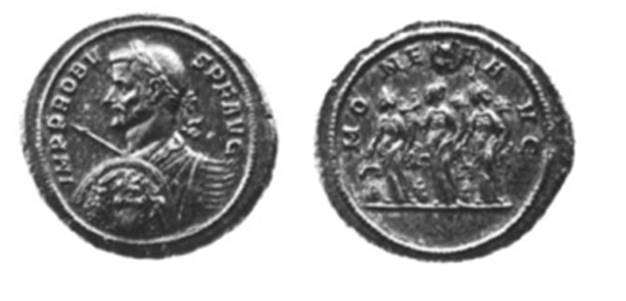Medallions. Medallion of Probus. Rome, 276-282. Bronze
Medallions represent the crowning achievement of Roman numismatic art. Although they were produced from the same materials, by the same methods, even by the same personnel as coins designed for broad circulation, at all periods they are stylistically superior to contemporary coins; their larger format permitted more ambitious compositions and encouraged more original ones and brought out the finest work of portrait engravers.
The regular production of medallions was a Hadrianic development and can be seen as a product of the artistic revival fostered by the emperor himself. Throughout the Hadrianic and Antonine periods medallions were struck primarily on thick bronze flans about 19/16 inch in diameter and weighing about 50 grams, or roughly twice the weight of the heaviest coin in normal circulation. The obverse was uniformly occupied by the bust of the reigning emperor or a member of his house; reverse types were drawn mainly from mythology or religion, and, particularly during the Antonine period, deities and personifications appear frequently. Important historical events— anniversaries of the foundation of Rome, provision for the succession, military success, death and deification of a member of the imperial house— also found their place. Medallions were intended for presentation to the nobility or foreign dignitaries; hence it is not surprising to find that the Roman custom of giving presents at the new year (strenae) is reflected in frequent "felicitas" types, and others celebrating the ruler's assumption of new titles at the new year.
The economic collapse of the third century had its effects on both the form and the content of medallions. What Toynbee has called "medallions proper"—those struck on substantial bronze flans —had disappeared almost entirely by the end of the century; here, this class is represented only by no. 30, of Probus. It was replaced by "money medallions," struck in precious metal and regularly conforming in weight to multiples of basic monetary units; the aureus (5.45 grams) or solidus (4.54 grams) in gold, the siliqua (2.60 grams) in silver. The change in material was accompanied by a change in typological emphasis: the rich repertory of pagan deities and personifications is seldom exploited, and heavy stress is laid upon the imperial house and the fortunes of the city of Rome. By the middle of the fourth century Christianity had emerged as an element of medallic typology; yet some of the pagan traditions— especially the New Year's or anniversary themes— continue in evidence until the mid-fifth century, when medallions virtually ceased to be struck.
Originally, production of medallions, as that of coins, was confined to the mint of Rome; in the late third century branch mints began to strike precious metal coinage, and marks were introduced to distinguish their products. These mint marks usually appeared in the exergue and consisted of one to four letters abbreviating a city name, often preceded or followed by other abbreviations whose significance is not always clear, ob (no. 42) may be either an abbreviation for obryzum, "pure gold," or the Greek numeral for 72; there were 72 solidi to the Roman pound. SM (nos. 33, 36, 40, and 41) seems to mean Sacra Moneta, "holy money [or mint]"; p (no. 32) and ps (no. 43) may abbreviate percussa ("struck," as in percussa Romae = "struck at Rome"), though this can hardly be proved. Occasionally arbitrary decoration was added to the mint mark (nos. 38-40), probably to distinguish the issue to which a medallion belonged.
Even though "money medallions" represented usable multiples of existing coins, such massive pieces as nos. 31 and 32 can hardly have been circulated as coin even if anyone had been crass enough to spend them. They were, however, hoarded as treasure in the same way as coins, and medallions have been discovered in far-flung parts of the empire, even outside it. //William E. Metcalf
Medallion of Probus. Rome, 276-282. Bronze. obv: iMP(erator) probvs p(ius) F(elix) AVG(ustus). Bust of Probus laureate, cuirassed left hand holding shield and spear.
rev : moneta AVG(usti). The three Monetae facing, holding balances and cornucopias; at their feet, piles of coins

The bust of Probus is firm and compact. The use of military garb reflects the predominantly military character of his reign, and his features are in every way those of a successful general. Yet, as Bellinger (1938, p. 129) noted, the posture of the bust is very awkward: either it is supposed to be seen from the rear (following a common later imperial convention, cf. no. 33) with the ridiculously small spear held in the concealed right hand, or, if it is seen from the front, the position of the spear and shield are inexplicable. Though partially obscured by piercing and refilling, the detail of the shield is remarkably fine: the emperor is shown on horseback preceded by a figure of Victory and followed by a soldier.
The reverse shows the three Monetae, who symbolize the three metals (gold, silver, and bronze) in which Roman coins were struck. Their balances represent the soundness and fineness of the coinage, their cornucopias the prosperity that resulted from their maintenance. The type was commonly employed throughout the third century —ironically a period of constant economic chaos— but it was particularly appropriate to the reign of Probus, who attempted to set the empire on a sounder economic footing.
The medallion was formerly in the E. T. Newell collection. Bibliography: Gnecchi, 1912, II, p. 118, no. 24; Fagerlie, 1969, no. 19.
Date added: 2025-07-10; views: 168;
